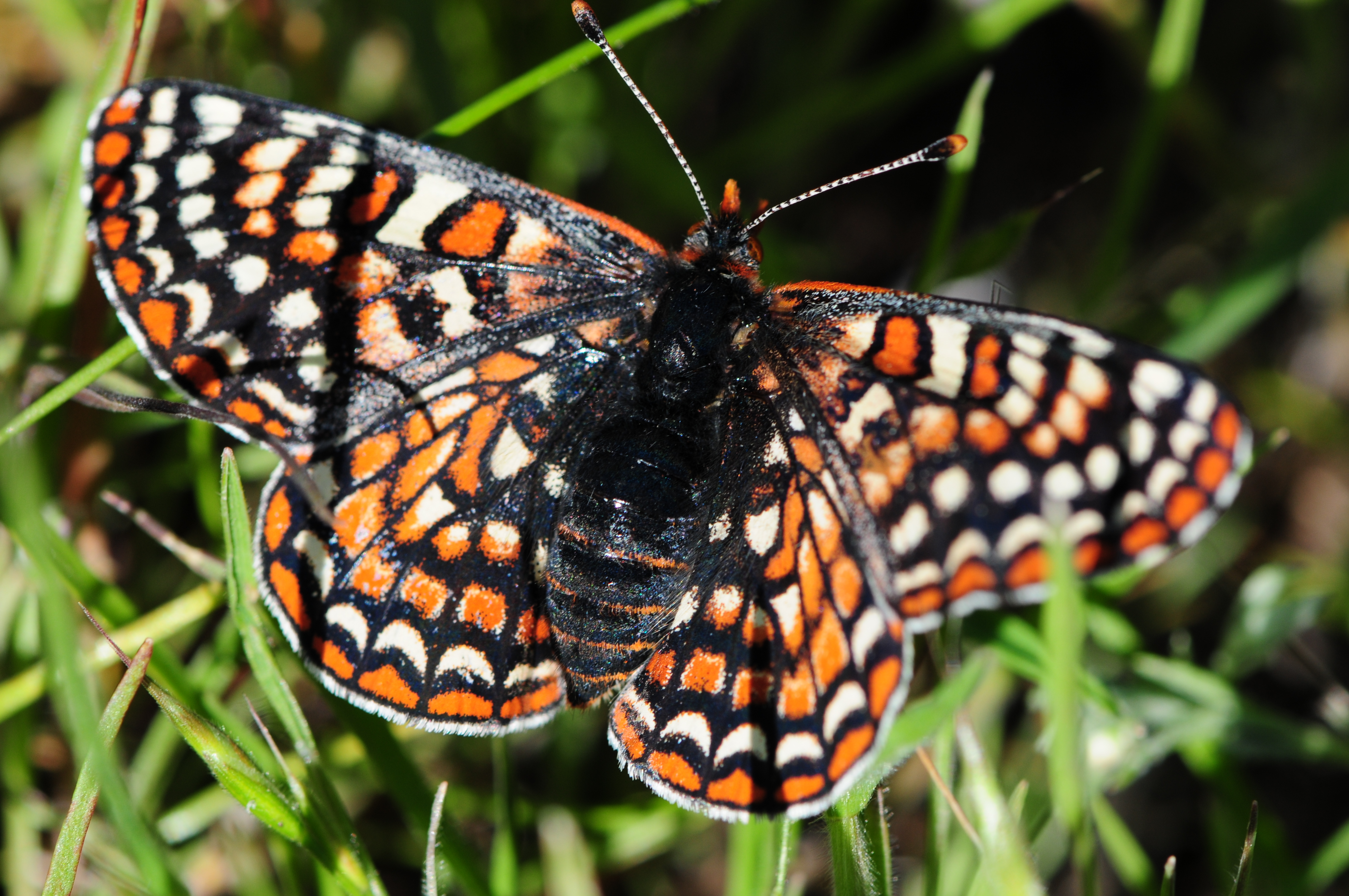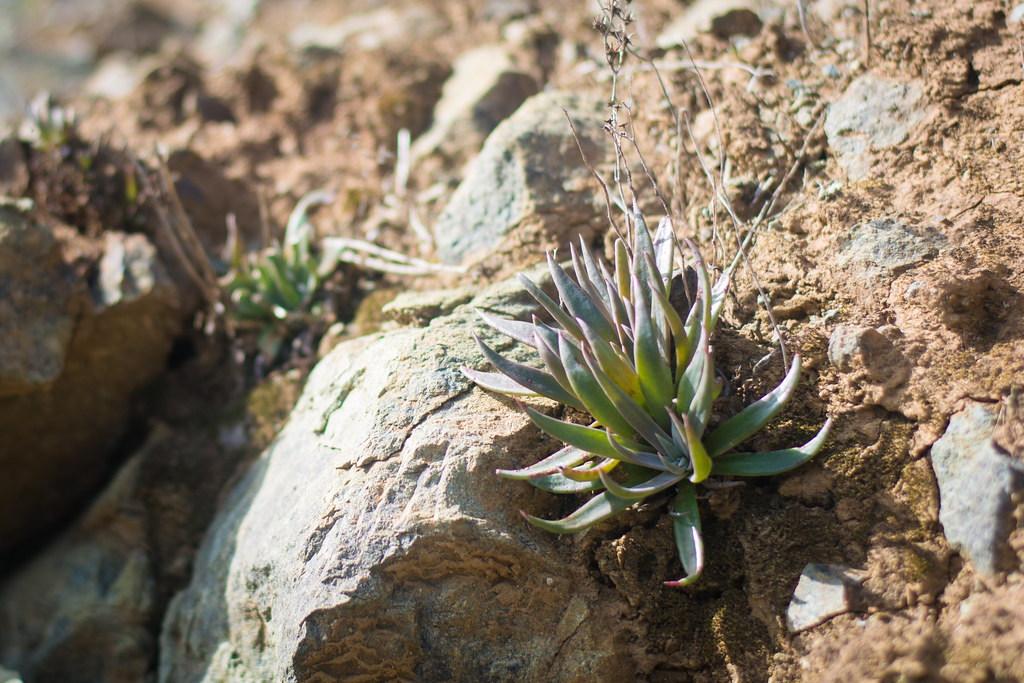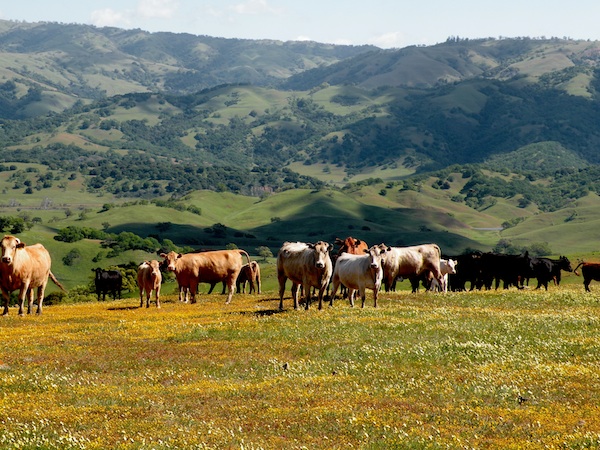Santa
Clara Valley Dudleya and The Bay-Checkerspot Butterfly
The Bay-Checkerspot Butterfly
(Courtesy of Flickr)
Ecology:
“Serpentinite
rock is a metamorphic member of the ultramafic family of rocks, derived from
the earth's mantle, surfacing where oceanic and continental plates collide.”However,
it is much more, serpentine creates unique habitats Santa Clara Valley Dudleya
(Courtesy of Flickr)
wherever it is found and is
California’s state mineral. The unique
chemical build up is generally toxic to most forms of life and lack of
nutrients creates little room for vegetative growth. However, the less than one percent of
California soil that is made up of serpentine rock supports a small but crucial
ecosystem of native plants and animals. One
of the unique plants found in Serpentine Soil is the Dudleya setchellii (Santa Clara Valley dudleya) and it supports the
life cycle the federally threatened Bay-Checkerspot Butterfly. While all native serpentine habitats are in
danger, I chose to focus on the general area of Coyote Valley, as it is where I
call home and the last major habitat of the Bay-Checkerspot Butterfly.
Photo Showing Coyote Valley (Courtesy of Marry Ellen Hannibal)
Geographic and
Population Changes
The species is
threatened by development, landfill activities, unauthorized dumping, quarry
expansion, and off-road vehicles. Sixteen
of the twenty known occurrences are partially or wholly on private land, and
most are subject to various levels of threat from development. As technology boomed in the Silicon Valley so
did the housing market and the technology parks necessary for the growing
industries. As a result a large amount
of serpentine soils were built on in noticeable ways. Some noticeable plots of local Santa Clara
Valley Dudleya and Bay-Checkerspot Butterfly habitat lost was that which
developed for more than 500 homes, the new Cal Pine Power Plant in Coyote
Valley, and the IBM campus adjacent to Tulare Hill.
Photo Showing Cal Pine Power Plant at Base of Tulare Hill
(Courtesy of Cal Pine)
Cause of listing and
Main Threats
Since the unveiling
of the recovery plan however, there have been updates and new discoveries
regarding the reasons of degradation in serpentine habitats and of the Santa
Clara Valley Dudleya. A Biologist by the
name of Stuart Weiss has discovered that much of the out-dominance of native
habitat can be attributed to over nitrification from the Highway 101 corridor
that intersects coyote valley and the serpentine habitats. The nitrogen released from the more than
110,000 cars that pass daily as well as diminishing grazing has allowed for
non-native annual grasses to dominate the landscape and shade out the Santa
Clara Valley dudleya. According to
Weiss, “You end grazing in the areas and it's bye-bye
butterflies."
Photo Showing the addition of two extra lanes of 101 thru Coyote Valley.
(Courtesy of Freeway Brent)
Description of
Recovery Plan
The original endangered
species Recovery plan outlined steps of isolating populations of the Santa
Clara Valley Dudleya as well as
limiting grazing and development.
However, what is interesting, has been watching the new developments in
the plans and actions. Since the
original study in 1998, the 101 corridor thru coyote valley has expanded from
two to four lanes and the powerplant has been finished and is now in
operation. While both of these lead to
further over nitrification, both projects set aside large plots of serpentine
habitat for Santa Clara Valley Dudleya as well as the threatened
Bay-Checkerspot Butterfly. These plots
of land as well as surrounding areas of Coyote Valley are being grazed again,
as grazing is now being encouraged rather than discouraged by government
officials in the area. Grazing has
proven to be possibly the largest factor in the survival of the Santa Clara
Valley Dudleya and Bay-Checkerspot Butterfly. By the mid-1990s,
the checkerspot's numbers on Coyote Ridge's northern end had dropped from about
50,000 to near extinction. However, in areas that have been well maintained and
grazed, the population hovers in the low hundreds of thousands.
Here Cows are seen grazing Coyote Ridge in order to Combat Non-Native Grasses
(Courtesy of Bay Nature)
Listing Date:
9/30/1998
Type Of Listing: Endangered
References:
http://botanicalgarden.berkeley.edu/about_us/images/press/archived_newsletters/Newsletter%201993-2.pdf
http://ecos.fws.gov/docs/recovery_plan/980930c_v2.pdf
http://www.washingtonpost.com/wp-dyn/content/article/2006/05/21/AR2006052100725_pf.html





